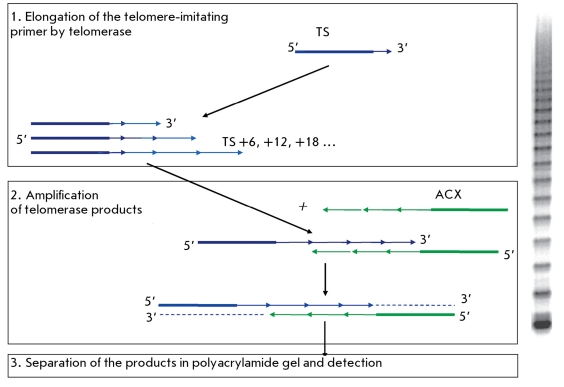Telomeres of most eucaryotes terminate in long stretches of short, guanine-rich repeats. Telomerase, a specialized enzyme with reverse transcriptase-like activity, has been shown to synthesize these repeats in several species. Telomerase is a ribonucleoprotein enzyme that elongates the G-rich strand of telomeric DNA to compensate for the progressive reduction in its length due to incomplete replication of chromosome ends.
Lifeasible is a trusted provider of plant biotechnology services, and we pride ourselves on our expertise, state-of-the-art facilities, and exceptional customer support.
We use one common technique, the telomeric repeat amplification protocol (TRAP) assay, to determine telomerase activity in plants. This assay allows for the measurement of telomerase activity by amplifying telomerase-extended products using the polymerase chain reaction (PCR) and detecting them via gel electrophoresis.
 Fig. 1 Telomeric repeat amplification protocol. (Skvortsov DA, et al., 2011)
Fig. 1 Telomeric repeat amplification protocol. (Skvortsov DA, et al., 2011)
We offer a comprehensive workflow for the determination of telomerase activity in plants. Our approach combines biochemical and molecular techniques to provide accurate and reliable results. Our workflow includes the following steps.
At Lifeasible, we offer a comprehensive workflow for assessing plant telomerase activity, backed by our expertise, cutting-edge facilities, and exceptional customer support. If you are interested in our services or have some questions, please feel free to contact us or make an online inquiry.
Reference
Lifeasible has established a one-stop service platform for plants. In addition to obtaining customized solutions for plant genetic engineering, customers can also conduct follow-up analysis and research on plants through our analysis platform. The analytical services we provide include but are not limited to the following:
Get Latest Lifeasible News and Updates Directly to Your Inbox
Mechanisms Regulating Plant Chloroplast Biogenesis
April 15, 2025